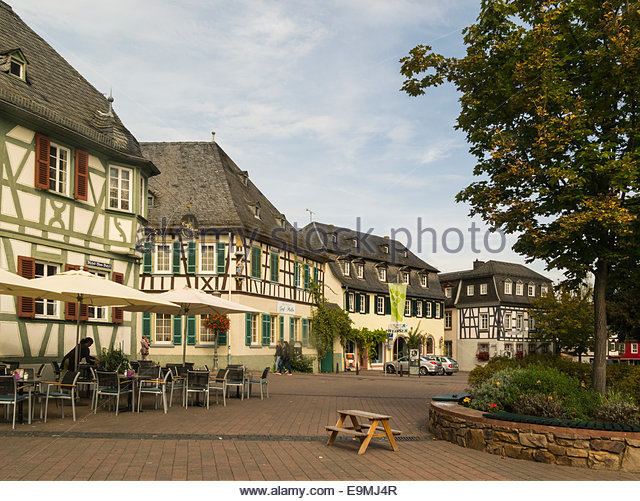Elevation 95 m (312 ft) Population 11,533 (30 Jun 2009) Postal code 65366 | Time zone CET/CEST (UTC+1/+2) Local time Saturday 1:41 PM | |
 | ||
Weather 11°C, Wind E at 11 km/h, 49% Humidity University Hochschule Geisenheim University | ||
Geisenheim is a town in the Rheingau-Taunus-Kreis in the Regierungsbezirk of Darmstadt in Hessen, Germany, and is known as Weinstadt (“Wine Town”), Schulstadt (“School Town”), Domstadt (“Cathedral Town”) and Lindenstadt (“Linden Tree Town”).
Contents
- Map of 65366 Geisenheim Germany
- Location
- Neighbouring communities
- Constituent communities
- History
- Town council
- Town partnerships
- Culture and sightseeing
- Buildings
- Palaces
- Sport
- Regular events
- Transport
- Education
- Sons and daughters of the town
- People associated with the town
- References
Map of 65366 Geisenheim, Germany
Location
Geisenheim lies on the Rhine’s right bank between Wiesbaden and Rüdesheim, 3 km away to the west. Mainz lies 21 km away to the east.
Neighbouring communities
Geisenheim borders in the north on the town of Lorch, in the east on the town of Oestrich-Winkel, in the south on the towns of Ingelheim and Bingen (both in Mainz-Bingen in Rhineland-Palatinate) and in the west on the town of Rüdesheim.
Constituent communities
The town of Geisenheim is divided into four Stadtteile: the main town (also called Geisenheim), Johannisberg (Grund, Berg, Schloßheide), Marienthal and Stephanshausen.
Johannisberg might well be the best known of Geisenheim’s constituent communities, being the birthplace of Spätlese (more precisely, the systematic production of Auslesen), and being known worldwide for its appellation.
At Schloss Johannisberg, a statue today still recalls the unknown Spätlesereiter (“Late Harvest Rider”). Through the vineyards here, below the Schloss runs the 50th parallel of north latitude.
Prince Klemens Wenzel von Metternich acquired the Schloss domain in 1816 after the Congress of Vienna from its former holder, Emperor Franz I as a gift.
Marienthal gets its name from the nearby Marienthal Monastery. The monastery is well known for its Marienwallfahrt (pilgrimage), and here was also the world’s first monastery printing shop.
History
Geisenheim had its first documentary mention in 772 and has belonged since the Middle Ages to the Archbishopric of Mainz and later to the Duchy of Nassau, the Kingdom of Prussia and the state of Hesse. Since 1864, Geisenheim has held town rights.
Town council
The municipal election held on 26 March 2006 yielded the following results:
The town’s arms might be described thus: Argent two towers with peaked roofs, between them a covered passage at the second floor, in the chief a wheel spoked of six, in the base a two-legged, winged, fire-breathing dragon sinister reguardant, a lance thrust through its mouth, the point protruding from the neck, the whole gules.
After municipal reform in 1972, the town’s arms were also adjusted insofar as the charges were altered to reflect the town’s absorption of several nearby villages, at least two of which had borne arms. The two former wheel charges – the “Wheels of Mainz” – were replaced with charges from the arms formerly borne by these outlying centres, above with a rather similar-looking wheel, but with six spokes instead of eight (from Johannisberg’s arms), and below with a dragon pierced through the mouth and neck with a lance (from Stephanshausen’s arms).
Town partnerships
The town of Geisenheim maintains partnerships with the following places:
Culture and sightseeing
Right before the town hall is found the great Linden tree, which stands as a symbol of the town. This tree is believed to be 700 years old. In the 1970s the tree lost its top to disease. Each year in the second week of July, the Lindenfest is held with the Stunde der Heimat (the “Homeland’s Hour”, during which citizens who have distinguished themselves are honoured) in the streets between the cathedral and the town hall.
Buildings
Resembling a cathedral, the gothic church Heilig Kreuz (Holy Cross) was finished by twin-towers only in the 19th century, similar to the cathedral in Cologne, and is therefore also called Rheingauer Dom. The architect of the neo-gothic facade and the towers was Philipp Hoffmann who also built landmarks in Wiesbaden. Nave and quire from the early 16th century, important tombs and rich interior décor and the rare Stumm organ from the romantic period make it worth seeing.
At the Pfefferzoll (“Pepper Toll”), ships sailing by town were once charged a toll in what was then a valuable spice. The little house with the lovely oriel window today stands more than 200 m from the Rhine in the southeast Old Town.
Furthermore, there is the Evangelical church, built in the Romanesque Revival style about 1897.
Palaces
In the town’s east and west stand old palaces.
Schloss Schönborn from 1550 stands at the railway station in the middle of a vineyard and is a popular spot for photographers. This palace today still belongs to the Counts of Schönborn-Wiesenheidt. Great parts of the palace complex, however, are in a bad state.
Other palaces:
Sport
Regular events
Transport
Running by Geisenheim is Bundesstraße 42 linking Wiesbaden with Koblenz. On the Right Rhine railway, Wiesbaden can be reached within 30 minutes, or in about an hour on the regional bus.
Since 2007, the Köln-Düsseldorfer Rheinschiffahrt, a well known Rhine passenger ship concern, has linked the centres of Marienthal, Johannisberg and Stephanshausen with Geisenheim.
There is even a landing stage for small, private boats without a set route plan.
Education
Geisenheim has its cluster of schools to thank for its reputation as a school town:
Since 1872, Geisenheim has been home to the Geisenheim Grape Breeding Institute for winegrowing and horticulture. The Institute cooperates in the field of education with the Fachhochschule Wiesbaden.
In Johannisberg is found Schloss Hansenberg. Since 2003 it has been an Oberstufengymnasium for especially well performing students.
